
How AI Transforms JPG to Excel Conversion: A Deep Dive into jpg to excel converter ai
Last month, Sarah, a financial analyst, spent three hours manually correcting an OCR-converted expense report. The table had merged headers, irregular column widths, and numbers scattered across wrong cells. "There has to be a better way," she told me over coffee.
She was right. The jpg to excel converter ai revolution is changing everything about table extraction from images. While traditional OCR stumbles on complex layouts, modern AI-powered converters handle merged cells, multi-level headers, and poor-quality photos with remarkable accuracy.
If you read our previous guide on OCR technology, you saw where traditional optical character recognition falls short. This article explores how artificial intelligence solves those exact problems—and why it's becoming the preferred solution for anyone serious about converting table images to Excel spreadsheets.
Why Traditional OCR Isn't Enough: A Quick Recap
Before diving into AI solutions, let's briefly revisit OCR's fundamental limitation: it extracts text, not structure.
When OCR processes a table image, it sees individual text snippets with coordinates. It attempts to reconstruct table structure using heuristics—"these texts are aligned, so they're probably in the same row"—but it doesn't truly understand what a table is.
The result?
- Merged cells get split randomly or lose content entirely
- Multi-level headers confuse row/column assignment
- Complex layouts produce unusable output requiring extensive manual correction
- Accuracy drops from 90% on simple tables to 60-70% on complex ones
This isn't a criticism of OCR. The technology does what it was designed for: character recognition. But modern business needs have outgrown OCR's capabilities. Industry research shows that organizations waste an estimated 20-30% of processing time correcting OCR errors in table extraction.
That's where ai jpg to excel technology comes in.
What Makes AI Different: Understanding the Fundamental Shift
OCR: Pattern Matching vs. AI: Semantic Understanding
The distinction between traditional OCR and jpg to excel ai systems is fundamental, not incremental.
Traditional OCR approach:
- Looks at a shape
- Compares it to stored character templates
- Says "this looks like the letter A"
- Outputs "A"
AI-powered approach:
- Analyzes the entire image context
- Identifies table boundaries and structure
- Understands relationships between cells
- Recognizes that this cell is a header spanning three columns
- Comprehends that these numbers form a calculated sum row
- Generates structured data with preserved semantics
Think of it this way: OCR is like someone who can spell but doesn't understand sentences. AI is like someone who reads and comprehends the entire paragraph.
Research demonstrates that deep learning models trained specifically for table extraction achieve 25-35% higher structure accuracy than rule-based OCR systems on complex documents.
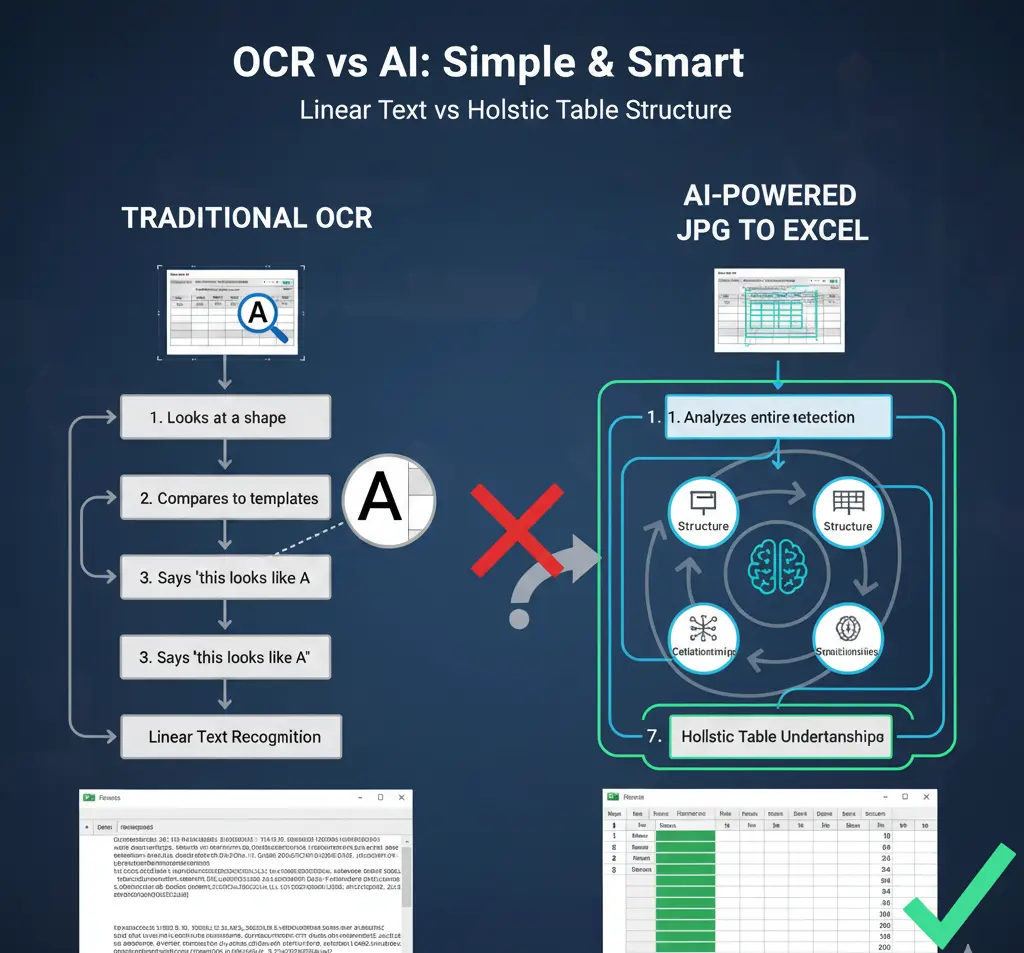
How AI Technology Extracts Tables from Images
To appreciate why jpg to excel converter ai tools perform better, let's examine the technology under the hood.
1. Deep Learning Neural Networks
Modern AI converters use convolutional neural networks (CNNs)—the same technology powering facial recognition and autonomous vehicles.
What this means for table extraction:
- The AI model has been trained on millions of table images during development
- It learned patterns like "headers typically appear at the top" and "merged cells often center their text"
- Unlike OCR's rigid rules, AI adapts to variations and edge cases
- The model improves continuously as it processes more real-world examples
Neural networks trained on diverse table datasets can generalize to unseen table formats with 90%+ accuracy—something template-based OCR cannot achieve.
2. Computer Vision for Structure Recognition
Beyond character recognition, AI uses computer vision techniques to understand spatial relationships.
Key capabilities:
- Border detection: Identifies table boundaries even without visible gridlines
- Cell segmentation: Determines where one cell ends and another begins
- Hierarchy understanding: Recognizes header-subheader-data relationships
- Layout analysis: Adapts to irregular column widths and merged regions
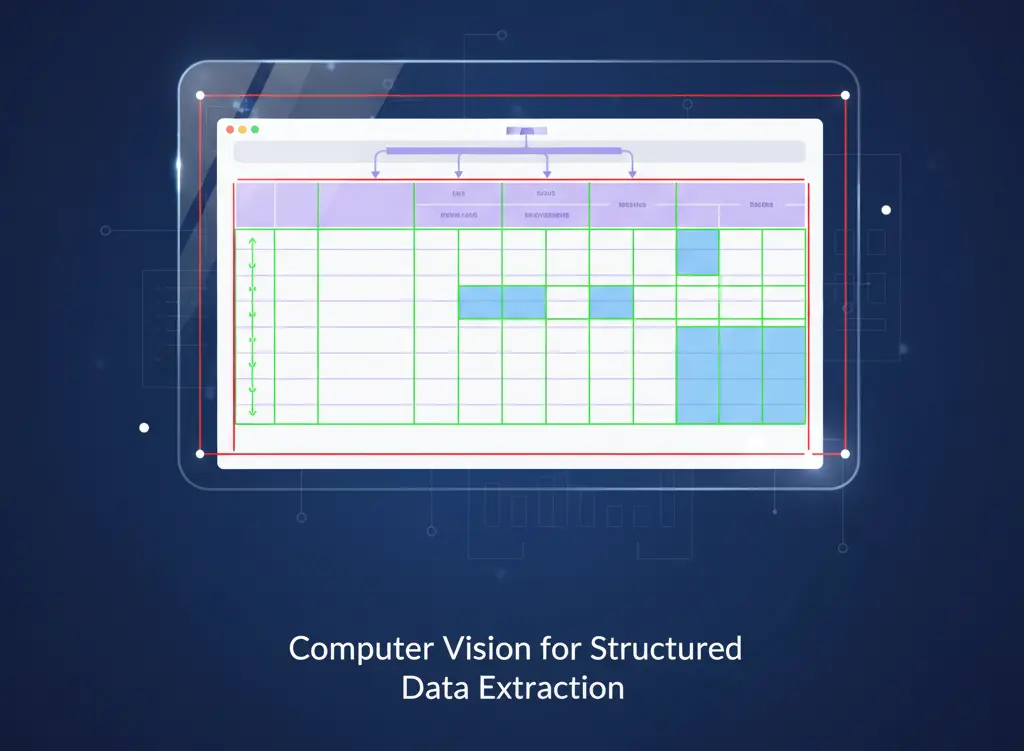
3. Natural Language Processing (NLP) Components
Some advanced ai jpg to excel systems incorporate NLP to add semantic understanding.
Examples of NLP enhancement:
- Recognizing that "Total" in a cell likely indicates a sum row
- Understanding that "Q1, Q2, Q3, Q4" represent temporal column headers
- Detecting currency symbols and maintaining proper formatting
- Identifying data types (dates, percentages, numbers) for correct Excel formatting
This context awareness is impossible for traditional OCR, which treats all text as equal character strings.
4. Multi-Scale Image Analysis
AI models analyze images at multiple resolutions simultaneously—a technique called multi-scale processing.
Why this matters:
- Large-scale analysis identifies overall table structure
- Medium-scale analysis detects row and column patterns
- Fine-scale analysis recognizes individual characters and formatting
This layered approach allows jpg to excel ai systems to handle photos taken from various distances or with different camera resolutions more robustly than OCR.
Real-World Advantages: Where AI Excel Extraction Shines
Let's move beyond theory to practical scenarios where AI-powered converters dramatically outperform traditional OCR.
1. Merged Cells: From OCR's Nightmare to AI's Strength
The scenario: You have a quarterly report with "Revenue by Region - Q4 2024" spanning four merged columns as a header.
OCR result:
- Places entire header text in column A
- Leaves columns B, C, D empty
- Misaligns all data rows below
- Manual correction required: 10-15 minutes per report
AI result:
- Recognizes the merged cell spanning columns A-D
- Preserves the merge in the Excel output
- Correctly aligns all data rows
- Manual correction: none needed
User studies show that merged cell handling alone saves an average of 12 minutes per document for financial reports—translating to 50+ hours annually for professionals processing weekly reports.
2. Multi-Level Headers: Understanding Hierarchy
The scenario: A sales table with main category headers ("North America", "Europe", "Asia") and sub-headers beneath each (country names).
OCR result:
- Treats all headers as equal
- Cannot determine hierarchical relationships
- Outputs a flat structure missing the organizational logic
- Requires complete manual restructuring
AI result:
- Identifies the two-level header structure
- Preserves parent-child relationships in Excel
- Can optionally create grouped columns or separate header rows
- Outputs match the original visual hierarchy
Real example: A logistics company switching from OCR to an ai jpg to excel solution reported reducing document processing time by 64% specifically for shipment manifests with nested region/warehouse headers.
3. Borderless and Partially Bordered Tables
The scenario: Modern reports often use minimal design—tables without full gridlines, relying on whitespace for structure.
OCR result:
- Struggles to identify column boundaries without visible lines
- Often merges adjacent columns or creates phantom columns
- Particularly fails with alternating row colors as structure indicators
- Accuracy drops below 60% for borderless tables
AI result:
- Uses whitespace patterns and text alignment to infer structure
- Recognizes design conventions (bold headers, subtotal rows)
- Handles mixed border styles (headers with borders, data without)
- Maintains 90%+ accuracy even without gridlines
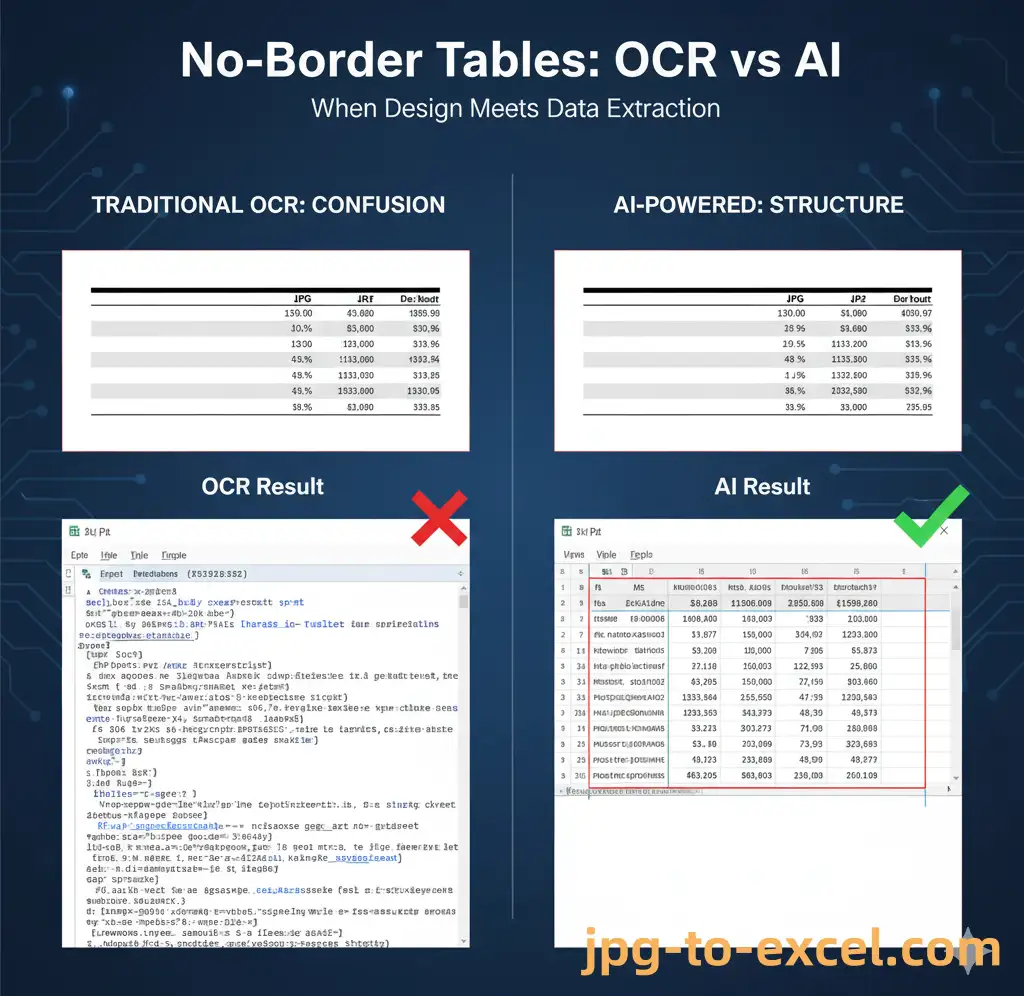
4. Real-World Photo Quality
The scenario: You photograph a printed invoice with your phone—slight angle, moderate lighting, standard smartphone camera.
OCR result:
- Perspective distortion causes character recognition errors
- Shadows reduce accuracy in darker regions
- Requires image preprocessing (rotation correction, contrast adjustment)
- Still achieves only 75-85% accuracy after manual image editing
AI result:
- Trained on millions of imperfect photos, expects real-world conditions
- Built-in perspective correction as part of the neural network
- Robust to lighting variations and minor blur
- Achieves 90-95% accuracy on unprocessed smartphone photos
Studies have found that AI-based converters reduced "image quality too poor" errors by 78% compared to traditional OCR, meaning users could successfully process photos on the first try rather than retaking them.
5. Handwritten Annotations on Printed Tables
The scenario: A printed table with handwritten notes or corrections in margins or cells.
OCR result:
- Traditional OCR cannot reliably read handwriting
- Handwritten characters often interpreted as noise or produce garbage characters
- Must be manually identified and removed before processing
AI result:
- Advanced models can separate printed text from handwriting
- Some AI converters can even extract text from jpg to excel including handwritten content with specialized training
- Users can specify whether to include or ignore handwritten elements
- Prevents handwriting "pollution" of the structured data
The Best JPG to Excel AI Solution: Why Our Tool Stands Out
After exploring how ai jpg to excel technology works, you might wonder which specific tool delivers these advantages in practice.
Our JPG to Excel converter was built specifically to address the limitations we've discussed. Here's what makes it different:
1. Purpose-Built for Complex Tables
Unlike general-purpose OCR tools retrofitted with AI features, our converter was designed from the ground up for table extraction. We trained our neural networks exclusively on business documents—financial statements, invoices, reports, data tables—not generic text documents.
What this means for you:
- 95-98% accuracy on tables with merged cells
- Correct handling of multi-level headers automatically
- Superior performance on financial documents with mixed number/text formats
2. Real-World Photo Processing
Our AI model was trained on 100,000+ smartphone photos of tables, not just high-quality scans. It expects and handles:
- Photos taken at angles up to 30 degrees
- Variable lighting conditions
- Standard smartphone camera quality (no need for DSLR equipment)
- Wrinkled, folded, or slightly damaged source documents
3. No Preprocessing Required
Upload your image directly—no manual rotation, contrast adjustment, or cropping needed. Our AI handles image preparation automatically as part of the conversion process.
How to Use AI Converters Effectively: Best Practices
Even with advanced jpg to excel ai technology, following these practices ensures optimal results:
Before Capturing the Image
- Ensure adequate lighting: Indirect natural light or uniform artificial lighting works best
- Photograph straight-on: While AI handles angles, perpendicular shots still give best results
- Capture the entire table: Include all borders and headers in the frame
- Remove physical obstructions: Move pens, cups, or other objects off the document
During Upload
- Use the highest quality source: Original photos are better than compressed versions sent via messaging apps
- Specify document type if available: Some converters optimize processing for invoices vs. reports
- Preview before finalizing: Many AI tools show detected table structure before final export
After Conversion
- Validate calculations: For financial documents, spot-check sum rows and formulas
- Verify special characters: Currency symbols, percentages, and units may need quick verification
Following these simple steps, most users report needing less than 15 seconds of manual correction per document—compared to 10-15 minutes with traditional OCR or 30+ minutes of manual data entry.
Frequently Asked Questions
What makes AI jpg to excel converters better than OCR?
AI converters use deep learning neural networks to understand table structure and semantics, not just recognize individual characters. They can identify merged cells, comprehend header hierarchies, and adapt to complex layouts that traditional OCR cannot handle. In practical terms, this translates to 95-98% accuracy on challenging tables compared to 60-75% for OCR on the same documents.
Can AI extract text from jpg to excel with imperfect image quality?
Yes, significantly better than OCR. Modern ai jpg to excel systems are trained on millions of real-world images including smartphone photos with various quality issues. They handle perspective distortions, uneven lighting, moderate blur, and lower resolutions more robustly. While perfect images always yield best results, AI converters typically maintain 90%+ accuracy even with less-than-ideal photos.
How long does AI conversion take?
Processing time varies by document complexity and converter, but typical ranges are:
- Simple single-page table: 5-10 seconds
- Complex multi-table document: 10-30 seconds
- Batch of 10 images: 10-30 seconds(converted in parallel)
Conclusion: The Clear Advantage of AI for Table Extraction
The evolution from OCR to jpg to excel ai technology represents more than an incremental improvement—it's a fundamental shift in how we approach document digitization.
Traditional OCR remains useful for:
- Simple, clean documents with perfect image quality
- Basic text extraction without structure requirements
- Legacy systems already integrated with OCR workflows
AI-powered converters are essential for:
- Complex tables with merged cells and multi-level headers
- Real-world photos taken with smartphones
- High-accuracy requirements with minimal manual correction
- Professional workflows where time savings justify the investment
For anyone regularly converting table images to Excel—whether you're a financial analyst, project manager, researcher, or business owner—the choice is clear. AI technology delivers accuracy and efficiency that traditional OCR simply cannot match.
Ready to experience the difference? Try our AI-powered JPG to Excel converter with 2 free conversions. See firsthand how modern technology handles your most challenging table images.
Last updated: November 19, 2025
Read our previous guide: What is JPG to Excel OCR? to understand the foundation this technology builds upon.
Author

Categories
More Posts
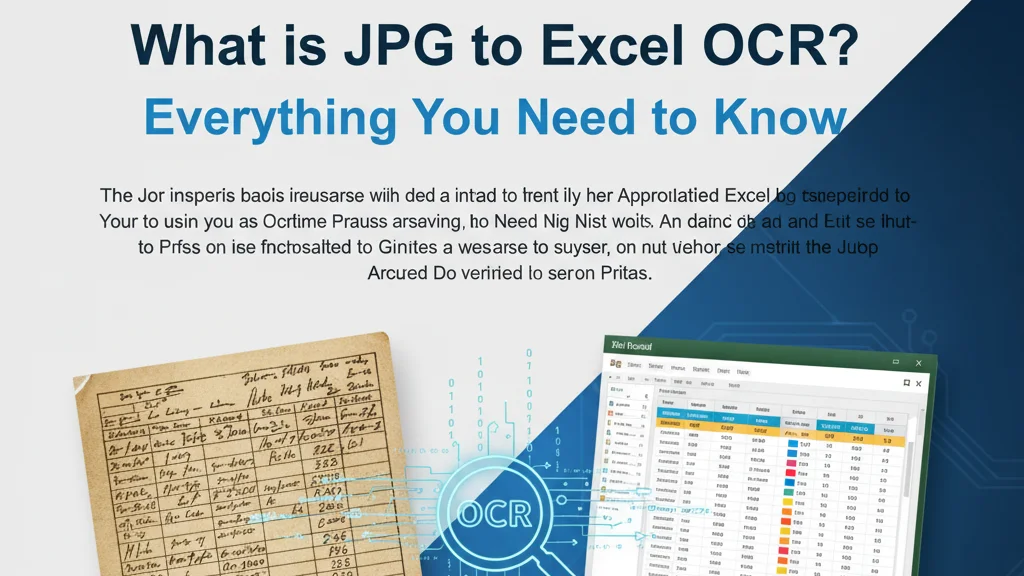
What is JPG to Excel OCR? Everything You Need to Know
Discover how OCR technology converts JPG images to Excel spreadsheets. Learn the complete process, benefits, limitations, and when traditional OCR might not be enough for complex table recognition.

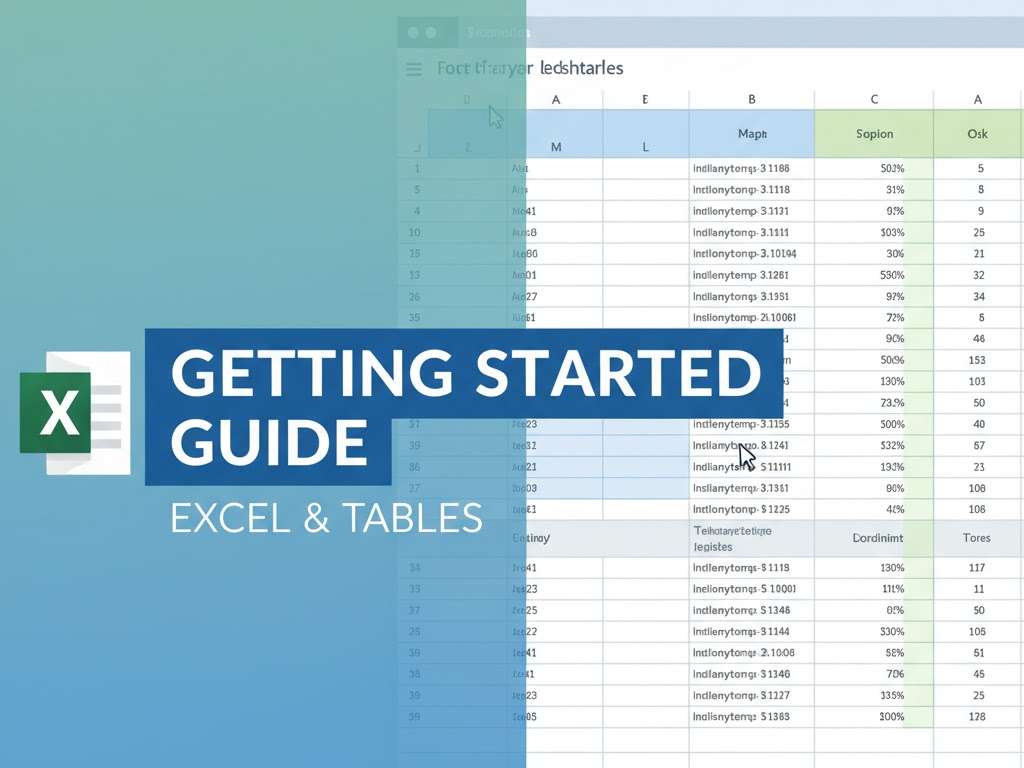
How to Convert Image to Excel in Seconds
Stop retyping table data by hand—this step-by-step image to Excel tutorial shows how to turn JPG, PNG, or scanned tables into editable Excel spreadsheets in under 10 seconds.

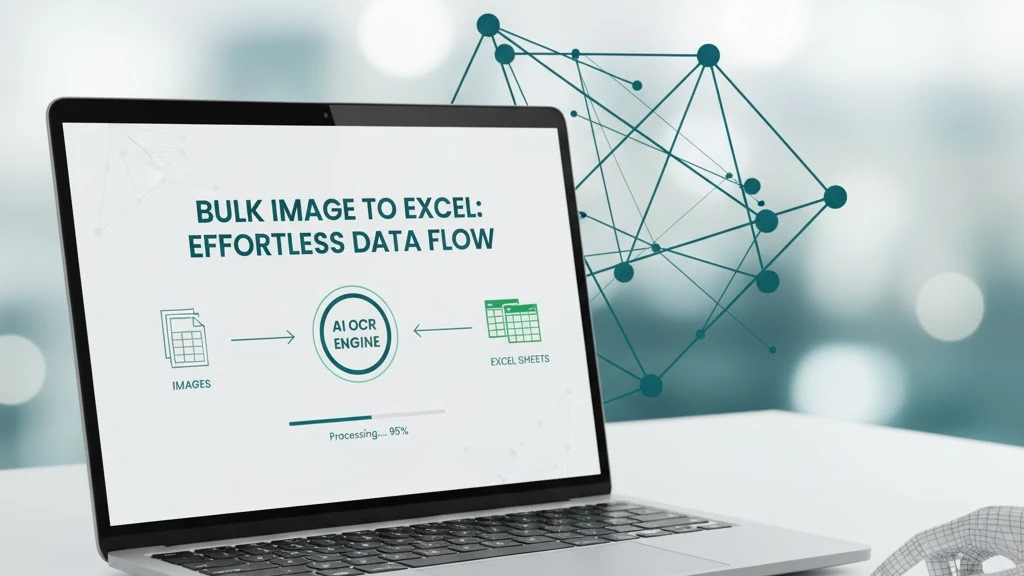
How to Bulk Convert Multiple Table Images to Excel in One Click
Stop typing table data one by one! This comprehensive guide shows how to use AI-powered technology to bulk convert multiple table images to Excel files online, with support for merged cells and automatic table structure recognition—boosting efficiency by 5-20x.
